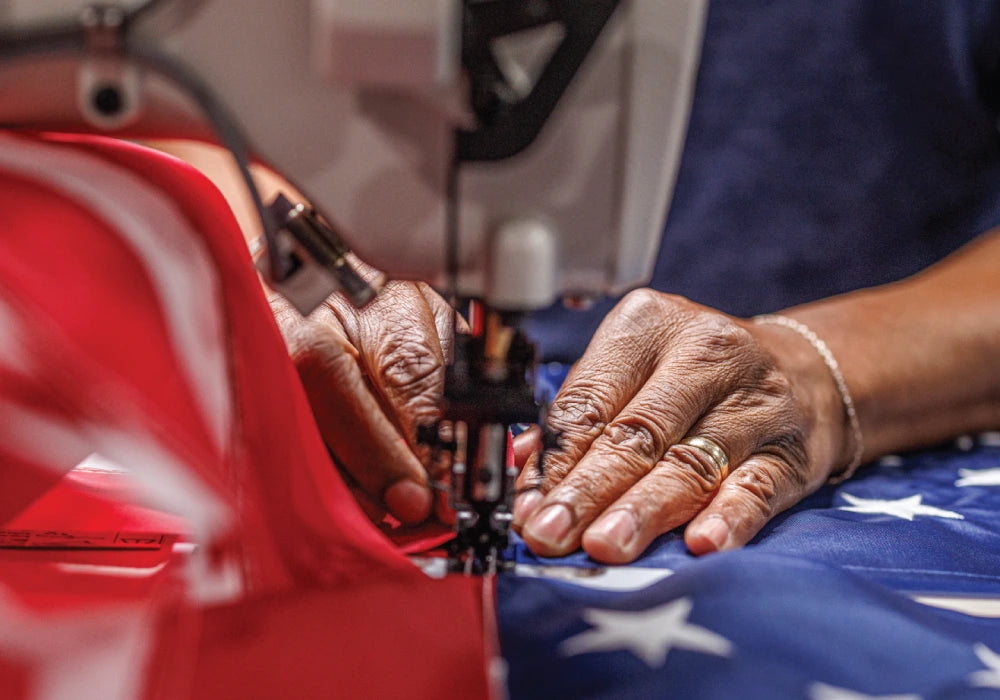Displaying the American flag at home is more than a patriotic gesture—it’s a symbol of pride and identity. When done thoughtfully, it also enhances the beauty of your home’s exterior. The right size, placement, and proportion can make your display stand out respectfully and elegantly. Whether you’re raising a standard American flag on a front porch or a tall pole in your yard, making it look balanced matters. Homeowners often overlook how much visual harmony can be achieved with proper planning. Instead of just buying any flag, it helps to pause and think about what fits your home’s style, structure, and surroundings.
Understanding Standard American Flag Specifications
Traditional USA Flag Measurements
The most common layout maintains a height-to-width ratio of 10:19, providing a rectangular shape that has become the national standard. This proportion keeps the flag visually pleasing and helps maintain the correct number of stars and stripes within a manageable layout. Each element of the flag fits within these dimensions. Understanding this layout helps homeowners select a flag that reflects traditional design and remains true to national standards.
How the 10:19 Ratio Affects Flag Proportions
The 10:19 ratio might sound like a small detail, but it plays a major role in how the flag looks when mounted or raised. If the ratio is off, the stars may seem too large or the stripes may feel crowded. A flag that follows this rule will wave with symmetry and grace, adding elegance to any home display. Check if it follows this ratio, as it's often the mark of a well-made product when considering an American flag size. Consistency in proportion is key for a proper presentation that respects tradition while complementing your outdoor setup.
Preserving Star Field and Stripe Count Accuracy
A crucial part of choosing a flag is ensuring it includes the correct number of stars and stripes, positioned accurately within the layout. Regardless of the flag's size, these elements must remain proportionally placed to uphold the integrity of the design. Every stripe has its place, and the field of stars should be aligned correctly with clear spacing and positioning. This attention to detail reflects national pride and shows respect for what the flag represents. For anyone buying an American flag for residential use, confirming these specifications can prevent you from ending up with a poorly made or unofficial version. It also guarantees your flag meets the expectations set by traditional and statutory guidelines.
Choosing the Best U.S. Flag Size for Your Home’s Architecture

Flag Sizes for Single-Story Homes
A smaller flag, such as 2½×4 feet, often pairs well with short poles or porch mounts, offering visibility without overwhelming the property. These dimensions provide a clean look while keeping the display proportional to the house's layout. Homeowners looking to add a patriotic element without cluttering the space can rely on these more compact sizes to achieve subtlety and elegance. When selecting from various flag sizes for homes, it’s important to consider the viewing angle and surrounding landscape, which affect how the flag appears from the street or sidewalk.
Display Options for Larger Residences
Taller homes naturally benefit from larger flags that match their height and expansive facades. Depending on the home's width and roofline, a 3×5 or even 4×6 foot flag may be appropriate. Larger homes have more visual weight, allowing them to support a bold flag display without it seeming oversized. A bigger flag adds presence and character in these settings, especially when hung from an upper-level balcony or on a ground-mounted pole near the entryway. Choosing an outdoor American flag with proper dimensions allows the flag to stand out.
Flag-to-Pole Ratio and Mounting Recommendations
Popular House-Mounted Flag Options
Wall-mounted displays remain one of the most accessible and common American flag flying methods. A 6-foot pole paired with a 3×5-foot flag offers strong visibility without overpowering the space. This setup works exceptionally well for porches, front columns, and garages, and it maintains a professional and respectful look. The pole angle typically extends the flag outward while providing sufficient clearance from windows and doors. Selecting this configuration ensures that the flagpole for home is appropriately matched to your flag, creating a well-balanced display suitable for daily use or holiday decoration.
Adjusting Size for Eight-Foot Poles and Larger Structures
For homeowners using larger or custom pole lengths, standard flags may not provide the visual impact you’re aiming for. In such cases, it’s wise to size up accordingly. For instance, a 4×6 foot flag fits nicely on an 8-foot pole, giving the flag enough presence without appearing cramped. Tall poles add height, but the overall look can fall flat without a proportional flag. Ensuring the right pairing helps the flag maintain its shape and catch the wind properly.
Custom Cuts and Banner Styles
Not all homes follow traditional design lines, and that’s where customized flags or banner-style alternatives come into play. These formats can be crafted in non-standard shapes or dimensions to accommodate unique structures, such as turrets, angled walls, or decorative archways. Custom flags can also reflect family heritage, personal design preferences, or specific mount types. For properties with limited space or non-traditional architecture, a custom American flag allows homeowners to fly their colors proudly without compromising fit or flow. Tailored sizes and styles bring flexibility while honoring the flag’s symbolism and traditional features.
Flagpole Selection and Installation Best Practices

Choosing Materials
The structure holding your flag should complement your environment, withstand local weather, and match your desired level of maintenance. Here are common at-home flagpole materials:
- Aluminum – One of the standout features of aluminum is its resistance to rust and corrosion, which allows it to maintain its appearance and structural integrity even in humid or rainy environments. The material is light enough for DIY installation, which reduces the need for professional labor. Aluminum flagpoles are also available in a variety of finishes, allowing homeowners to match the pole to their home’s exterior or landscape design. Also, aluminum poles are often tapered for improved wind resistance and visual appeal. While not as strong as steel, they are sturdy enough for average-height displays and provide a professional appearance without added complexity. Maintenance is relatively simple, usually limited to occasional rinsing or polishing, depending on the finish.
- Fiberglass – Fiberglass flagpoles are uniquely suited for regions that experience high winds, frequent storms, or coastal conditions. The material is inherently non-conductive, making it a safer option in areas with a high risk of lightning strikes, such as near the ocean or in storm-prone regions. Unlike metal poles, fiberglass won’t corrode or oxidize when exposed to salty air, making it a durable solution for beachfront properties or boats. Another significant benefit is its inherent flexibility, which allows it to bend slightly with the wind instead of breaking or becoming damaged. This flexibility enhances the pole’s lifespan and reduces flag and halyard system stress. Fiberglass poles are usually finished with a glossy gel coat, which helps preserve their color and resists fading from UV exposure. While they may not offer the same metallic aesthetic as aluminum or steel, fiberglass poles have a clean, modern look. They are available in white or custom colors to match your design preferences. Installation is straightforward but might require assistance depending on the pole’s height.
- Steel – Known for their unmatched strength and commanding presence, steel poles are typically used in commercial or ceremonial settings where height, permanence, and formal aesthetics are paramount. Their added weight contributes to a more grounded, imposing appearance, often required for government buildings, memorial parks, or large public spaces. Steel has a higher tensile strength, allowing for the construction of very tall poles without sacrificing stability. However, steel is susceptible to rust and requires regular upkeep, including protective coatings like galvanization or powder coating to guard against corrosion. The installation process is also more complex due to the material’s density, often necessitating machinery or professional services. Despite these challenges, many choose steel for its classic look and superior durability in fixed, long-term installations. It is less flexible than fiberglass and can transmit noise through the pole during high winds, which may be a concern in residential zones.
Understanding the benefits and trade-offs of aluminum, fiberglass, and steel can help you confidently select a flagpole that aligns with your aesthetic goals and environmental needs.
Factors That Affect Stability
Several elements determine how well a flagpole holds up over time, including wind load capacity, base structure, and exposure to the elements. Even poles made of durable material can falter if not properly installed or anchored. Taller poles require deeper foundations and often benefit from reinforced mounts. Additionally, environmental conditions such as rainfall, sun exposure, and temperature shifts can speed up wear if not addressed.
Proper Anchoring and Setback for Ground Poles
Ground-set poles should be installed with the correct depth-to-height ratio, often requiring a concrete base to stay upright and stable. For example, a 20-foot pole typically requires at least 2 feet of base depth. Adequate setback from walkways, driveways, and windows is also essential to prevent interference and maintain safety. When considering an American flag price, remember to factor in installation costs for foundation work and mounting materials. While professional installation may seem like an added expense, it significantly increases safety and lifespan.
Practical Considerations for Climate and Materials
Seasonal Display Adjustments for Wind and Storms
Weather plays a significant role in how your flag looks and lasts throughout the year. It’s wise to adapt your display to suit the climate in regions with heavy seasonal changes. During winter storms or summer heat waves, flags can wear down quickly due to high winds, rain, and UV exposure. In such cases, rotating between display and backup flags can extend longevity. Homeowners living in areas prone to strong gusts should consider reinforced stitching or flags with lock-stitched edges.
Comparing Fabrics
The material determines how well the flag handles environmental elements like rain, wind, and sun, as well as how it looks while displayed. Here are the most common flag fabrics:
- Nylon – One of its key advantages is its lightweight nature, which allows it to fly easily even in a gentle breeze. This movement gives the flag a dynamic, animated look, making it a visually appealing option for homeowners and businesses. Nylon fabrics also hold color, giving the flag a vivid, glossy appearance that stands out in most lighting conditions. In addition to aesthetics, nylon is highly functional. It resists mildew, an important feature in humid or damp environments, and dries quickly after rainfall, minimizing the risk of water damage or discoloration. Nylon flags typically come with reinforced headers and sturdy stitching, which extend their life in moderate weather. However, they may not perform as well in extremely windy conditions, as their lighter fabric is more prone to tearing when consistently stressed.
- Polyester – Heavier and more rugged than nylon, polyester excels in withstanding high winds, prolonged sunlight, and abrasive environmental conditions. It is especially popular in coastal regions, wide-open fields, or areas with frequent storms where durability is crucial. The material’s strength reduces fraying and helps the flag maintain its structure over time. Polyester flags are often woven with a two-ply or spun construction, giving them a textured, matte appearance that some find more traditional than the sheen of nylon. While they may not flutter as easily in a light breeze, they are far more likely to hold up under constant stress. This makes them a favorite for large flags mounted on tall poles, such as those used by schools, government buildings, or industrial facilities.
- Cotton – Cotton flags offer a timeless, classic appearance that’s well-suited to indoor settings, historical displays, and ceremonial use. The natural fibers give these flags a rich, textured feel and a subdued color palette that many find charming and dignified. Because of this aesthetic quality, cotton is often the fabric of choice for flags used in parades, memorial services, or as part of vintage-style décor. However, cotton does not fare well under harsh weather. It tends to absorb moisture, leading to fading, mildew, and eventual fraying when exposed to rain, snow, or intense sunlight for prolonged periods. Unlike synthetic fabrics, cotton lacks the durability and color retention needed for continuous outdoor display. Its heavier weight also means that it requires stronger winds to move fluidly, limiting its motion on calm days.
Each fabric offers a distinctive combination of attributes that ensures your flag performs and presents as intended.
Displaying the American flag at home is both a personal and patriotic act. Whether your space is large or small, finding the right balance between scale and style creates a strong visual impact while honoring the flag’s meaning. Every decision, from selecting the pole to choosing the fabric and dimensions, creates a display that feels cohesive and respectful. These flag sizing tips aren’t just about placing it anywhere—it’s about showcasing it to enhance your property while maintaining its symbolic value. The right American flag for residential use captures both patriotism and taste, giving you a display that inspires admiration and respect.






